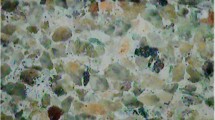Abstract
Tension-induced fractures and fractures formed by saw-cut surfaces and polished surfaces were prepared in salt specimens. A series of gas flow testing was performed to monitor the changes of the fracture permeability under quasi-static loading (0.7–20 MPa) for up to 120 h. Healing tests under static loading were carried out under both dry and saturated conditions. The results suggest that the primary factors governing the healing of salt fractures are the origin and purity of the fractures, and the magnitude and duration of the fracture pressurization. Inclusions or impurities significantly reduce healing effectiveness. The hydraulic conductivity of fractures in pure salt can be reduced permanently by more than 4 orders of magnitude with applied stresses of 20 MPa for a relatively short period. In most cases the reduction of salt fracture permeability is due to fracture closure, which does not always lead to fracture healing. The closure involves visco-plastic deformation of the asperities on both sides of the salt fracture, while the healing is related to the covalent bonding between the two surfaces. Fracture roughness and brine saturation appeared to have an insignificant impact on the healing process.
Résumé
A partir d’échantillons de sel, des fractures ont été obtenues par rupture en traction ou ont été élaborées à partir de surfaces sciées et polies. Une série de tests d’écoulement de gaz a été réalisée pour suivre les évolutions de perméabilité de fracture sous chargement quasi-statique (0,7 à 20 MPa) pendant des durées allant jusqu’à 120 h. Des tests de cicatrisation sous chargement statique ont été réalisés sous des conditions sèches ou saturées. Les résultats suggèrent que les facteurs principaux contrôlant la cicatrisation des fractures dans le sel sont l’origine et la pureté des fractures ainsi que l’importance et la durée de la mise en pression des fractures. Les inclusions ou les impuretés réduisent de façon significative l’efficacité de la cicatrisation. La conductivité hydraulique des fractures dans le sel pur peut être réduite de façon permanente de plus de quatre ordres de grandeur avec des contraintes appliquées de 20 MPa pendant une période relativement courte. Dans la plupart des cas la diminution de la perméabilité de fracture du sel est due à la fermeture de la fracture, ce qui ne conduit pas toujours à sa cicatrisation. La fermeture implique une déformation visco-plastique des aspérités sur les deux lèvres de la fracture dans le sel, tandis que la cicatrisation est relative aux liaisons covalentes entre les deux lèvres. La rugosité de fracture et la saturation en saumure apparaissent avoir un impact insignifiant sur le processus de cicatrisation.












Similar content being viewed by others
References
Allemandou X, Dusseault MB (1993) Healing processes and transient creep of salt rock. In: Geotechnical engineering of hard soils-soft rocks. Balkema Publishers, Rotterdam, Netherlands, pp 1581–1590
ASTM D3967-81 (1981) Standard test method for splitting tensile strength of intact rock core specimens. In: Annual book of ASTM standards. American Society for Testing and Materials, Philadelphia, 04.08
ASTM D4543-85 (1985) Standard practice for preparing rock core specimens and determining dimensional and shape tolerances. In: Annual book of ASTM standards. American Society for Testing and Materials, Philadelphia, 04.08
ASTM D5731-95 (1995) Standard test method for determination of the point load strength index of rock. In: Annual book of ASTM standards. American Society for Testing and Materials, Philadelphia, 04.08
ASTM D2938-79 (1979) Standard test method for unconfined compressive strength of intact rock core specimens. In: Annual book of ASTM standards. American Society for Testing and Materials, Philadelphia, 04.08
Chan KS, Munson DE, Fossum AF, Bodner SR (1998) A constitutive model for representing coupled creep, fracture and healing in rock salt. In: Proceedings of the 4th conference on the mechanical behavior of salt, The Pennsylvania State University, June 17–18, 1996. Clausthal-Zellerfeld, Trans Tech Publications, Germany, pp 211–234
Habib P, Berest P (1993) Rock mechanics for underground nuclear waste disposal in France. In: Hudson JA (ed) Comprehensive rock engineering, vol 5. Pergamon Press, Oxford, UK, pp 547–563
Katz DL, Lady ER (1976) Compressed air storage for electric power generation. Dept. of Energy, Pacific Northwest, Richland, Washington
Miao S, Wang ML, Schreyer HL (1995) Constitutive models for healing of materials with application to compaction of crushed rock salt. J Eng Mech ASCE 10(121):1122–1129
Munson DE, Chan KS, Fossum AF (1999) Fracture and healing of rock salt related to salt caverns. SMRI Report, Spring Meeting, April 14–16, Las Vegas. Nevada. Solution Mining Research Institute, Encinitas, CA
Ouyang S, Daemen JJK (1989) Crushed salt consolidation. Technical Report NUREG/CR-5402. U.S. Nuclear Regulatory Commission, Washington, DC
Renard F (1999) Pressure solution and crack healing and sealing. Institute of Geology and Department of Physics. Charles University, Prague; Summer school on: Geology related to nuclear waste disposal, July 5–11, Roztez, Czech Republic. University of Oslo, Norway
Suwanich P (1986) Potash and rock salt in Thailand. Nonmetallic Minerals Bulletin No.2. Economic Geology Division, DMR, Bangkok, Thailand
Warren J (1999) Evaporites: their evolution and economics. Blackwell Science, Oxford, UK, p 438
Zeigler TW (1976) Determination of rock mass permeability. Technical Report S-76-2, U.S. Army Engineer Waterways Experiment Station, Vicksburg, Mississippi
Acknowledgment
This research is funded by Suranaree University of Technology. Permission to publish this paper is gratefully acknowledged.
Author information
Authors and Affiliations
Corresponding author
Rights and permissions
About this article
Cite this article
Fuenkajorn, K., Phueakphum, D. Laboratory assessment of healing of fractures in rock salt. Bull Eng Geol Environ 70, 665–672 (2011). https://doi.org/10.1007/s10064-011-0370-y
Received:
Accepted:
Published:
Issue Date:
DOI: https://doi.org/10.1007/s10064-011-0370-y




